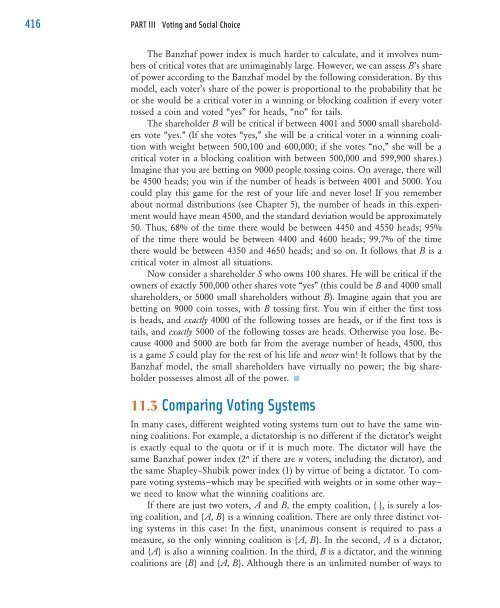Weighted Voting Systems - W.H. Freeman
Weighted Voting Systems - W.H. Freeman
Weighted Voting Systems - W.H. Freeman
- No tags were found...
Create successful ePaper yourself
Turn your PDF publications into a flip-book with our unique Google optimized e-Paper software.
416 PART III <strong>Voting</strong> and Social ChoiceThe Banzhaf power index is much harder to calculate, and it involves numbersof critical votes that are unimaginably large. However, we can assess B’s shareof power according to the Banzhaf model by the following consideration. By thismodel, each voter’s share of the power is proportional to the probability that heor she would be a critical voter in a winning or blocking coalition if every votertossed a coin and voted “yes” for heads, “no” for tails.The shareholder B will be critical if between 4001 and 5000 small shareholdersvote “yes.” (If she votes “yes,” she will be a critical voter in a winning coalitionwith weight between 500,100 and 600,000; if she votes “no,” she will be acritical voter in a blocking coalition with between 500,000 and 599,900 shares.)Imagine that you are betting on 9000 people tossing coins. On average, there willbe 4500 heads; you win if the number of heads is between 4001 and 5000. Youcould play this game for the rest of your life and never lose! If you rememberabout normal distributions (see Chapter 5), the number of heads in this experimentwould have mean 4500, and the standard deviation would be approximately50. Thus, 68% of the time there would be between 4450 and 4550 heads; 95%of the time there would be between 4400 and 4600 heads; 99.7% of the timethere would be between 4350 and 4650 heads; and so on. It follows that B is acritical voter in almost all situations.Now consider a shareholder S who owns 100 shares. He will be critical if theowners of exactly 500,000 other shares vote “yes” (this could be B and 4000 smallshareholders, or 5000 small shareholders without B). Imagine again that you arebetting on 9000 coin tosses, with B tossing first. You win if either the first tossis heads, and exactly 4000 of the following tosses are heads, or if the first toss istails, and exactly 5000 of the following tosses are heads. Otherwise you lose. Because4000 and 5000 are both far from the average number of heads, 4500, thisis a game S could play for the rest of his life and never win! It follows that by theBanzhaf model, the small shareholders have virtually no power; the big shareholderpossesses almost all of the power. 11.3 Comparing <strong>Voting</strong> <strong>Systems</strong>In many cases, different weighted voting systems turn out to have the same winningcoalitions. For example, a dictatorship is no different if the dictator’s weightis exactly equal to the quota or if it is much more. The dictator will have thesame Banzhaf power index (2 n if there are n voters, including the dictator), andthe same Shapley–Shubik power index (1) by virtue of being a dictator. To comparevoting systems—which may be specified with weights or in some other way—we need to know what the winning coalitions are.If there are just two voters, A and B, the empty coalition, { }, is surely a losingcoalition, and {A, B} is a winning coalition. There are only three distinct votingsystems in this case: In the first, unanimous consent is required to pass ameasure, so the only winning coalition is {A, B}. In the second, A is a dictator,and {A} is also a winning coalition. In the third, B is a dictator, and the winningcoalitions are {B} and {A, B}. Although there is an unlimited number of ways to
















